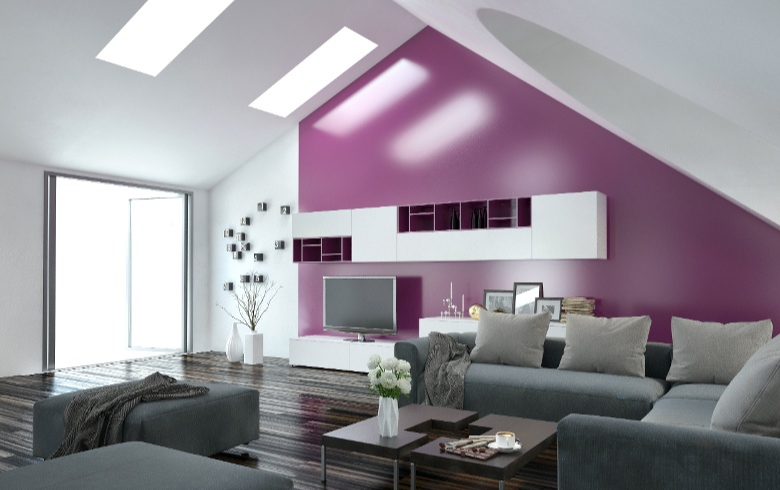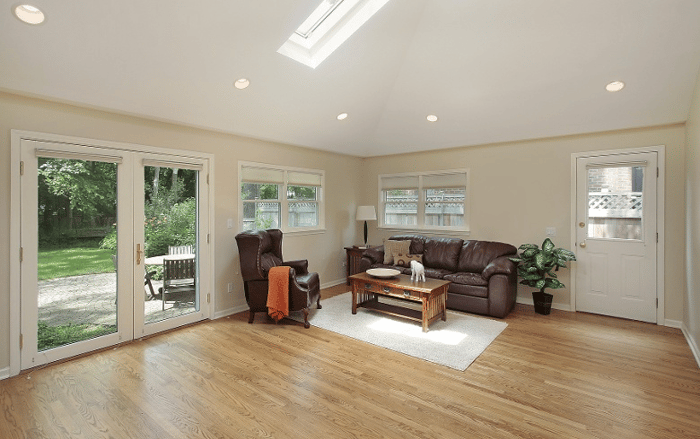Enhance Your Living Room Colors with Light
Read Time 2 mins | Written by: VELUX Skylights

Light and color have a unique relationship. Light influences colors, changing their shade and tint constantly.
Color responds to an array of different light variables: location of the sun, time of day, and type of light all affect how your color will ultimately look. Knowing how the colors you choose transform when added to your room is an excellent trick to have in your designer tool bag. After all, what could be worse than completely repainting an entire room only to discover the color doesn't bode well for the space?
For success with your color of choice, keep these key factors in mind while you're shopping for your next paint.
Room Direction
From which direction does sunlight hit your living room? Determining this is your first step to picking out the perfect paint color.
- North: A north facing room gets less direct sunlight throughout the day, meaning it's consistently cooler than your other rooms. To warm this room up, opt for warmer colors. Or, if you want to just go with the cool light, paint it a dark, cozy shade - perfect for a library or den!
- Psst! North facing rooms are also the perfect place to add in skylights, which provide a room with full, clean natural light.
- East: Where does the sun rise? In the east! East facing rooms get most of their light in the morning, and it's more yellow. Later in the day, however, the light turns a bluer color, so these rooms do best with reds, oranges, and yellows.
- West: Rooms that face west, where the sun sets, benefit from its rays with a warm glow in the evening. Consider toning down the light in this room with cooler paint colors.
- South: Your south facing rooms are the sunniest places in your home! Because these rooms receive more light throughout the day, colors can look more intense. If you don't want these rooms to feel too energetic, offset the light with softer, cooler hues.
Time of Day
As we've already established, the sun doesn't remain at a fixed point in the sky. As it moves and affects color perception, it dramatically changes the look and feel inside your home.
- Morning: Early light has a mixture of warm colors. As a result, it gives the paint a luminous glow.
- Afternoon: At noon, light is distinctly bluer. And often when the sun is at its peak, color can get washed out.
- Evening: As the sun approaches the horizon again near sundown, the light becomes warmer. So, surprisingly, in the evening, certain colors can become brighter and more intense.
Don't Forget the Light Bulbs
Chances are, you're not illuminating every room in your home solely with daylight. So, it's important to consider how the light from the bulbs you're using affect color as well.
- Incandescents: These bulbs emit a warm, yellow-amber light which makes reds, oranges, and yellows more vivid while muting blues and greens.
- Fluorescents: These flat, cool light bulbs enrich blues and greens but diminish warmer hues.
- Halogens: Made to resemble natural light, these bulbs make colors look more vivid. Halogens can make the shift from daylight to artificial light less jarring.
- Compact fluorescent lights (CFLs): Check these bulbs' boxes: CFLs can produce either a warm white, neutral, or bluish-white light.
- Light-emitting diodes (LEDs): The light bulbs of the future, LEDs can provide warm or cool light. You can even get "smart" LEDs whose color you can control wirelessly.
VELUX Skylight Systems
Reimagine Your Home With Natural Light and Fresh Air

HEALTHY LIVING
Survive This Winter by Living the Hygge Life
Are you ready to live hygge this winter? We'll tell you how!
Keep Reading
HALLWAY
Natural Light in the Core of Your Home
Illuminate your whole house by installing skylights in the core of your home: its hallways.
Keep Reading
LIVING ROOM
3 Reasons to Love Skylights in Your Living Room
Three reasons to convince you the only thing missing from your living room is a skylight!
Keep Reading